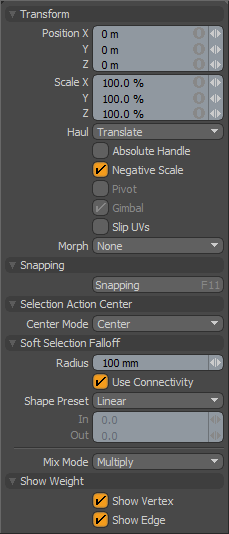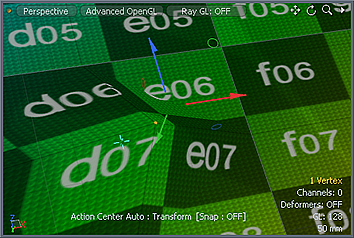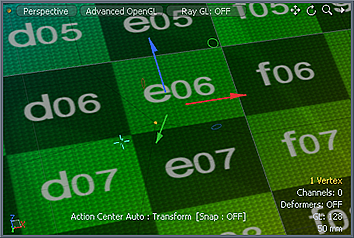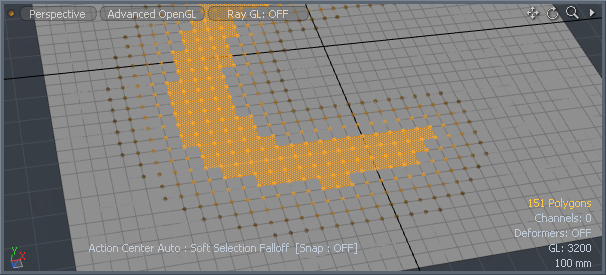

Found in the Deform sub-tab of the modeling toolbox (sometimes as a subtool of one of the other Soft Selection tools), the Soft Select Transform tool is a deformation tool. With it, you can simultaneously move, rotate, and scale the selected geometry rigidly while gradually attenuating the translation outside of the selected area defined by the Soft Selection Radius. As the Radius value increases, so does the softness of the transformation.
Transform—
Position X/Y/Z: Displays the offset distance for each axis (calculated from the position the object was in when you activated the tool). When adjusting an object interactively in the viewport, the Position values indicate the current offset distance applied.
Scale X/Y/Z: Displays specific scaling values applied to the geometry. When adjusting an object interactively in the viewport, the Scale input values indicate the current scale factor applied.
Haul: Specifies what action dragging the pointer (when not dragging tool handles) does in the viewport.
Translate- Moves the selection.
Rotate- Rotates the selection.
Scale- Resizes the selection.
Absolute Handle: When enabled, applies an additional function to the tool handles for you to scale the handle itself without affecting the transform amount. In some cases this provides finer control over very large or very small adjustments.
Negative Scale: When enabled, applies negative scale values, if appropriate, when you manipulate the tool handles in the viewport. When disabled, Modo does not automatically change the values if they are negative. You can always input negative values directly.
Pivot: Disabled for the Soft Select Transform tool.
Gimbal: Disabled for the Soft Select Transform tool.
Slip UVs: (Only in Component Modes) When enabled, edits applied to the geometry do not change the existing UV map. UV values are generally fixed to specific vertices; therefore, further edits to the geometry may warp, deform, or otherwise distort the UV values in undesirable ways. When this happens, you may need to adjust the map or to redo it altogether. To avoid this undesirable result, you enable Slip UVs so as to not disturb any existing UV mapping applied to the geometry.

Slip UVs function disabled (notice the texture warping) |

Slip UVs function enabled (texture remains even) |
Morph: (Only available in Component modes) Determines how Modo treats stored morphing information when applying transforms (such as the Move, Rotate, or Scale transforms) to geometry. There are three options for controlling how Modo deals with the morph map vertex data when applying any transforms.
None- Transforms selected (visible) morphs independent of their source, but does not affect unselected morph data.
Transform- Transforms morph data along with the base mesh.
Keep Positions- Converts morph data into an absolute morph map. All vertices retain their pre-transformed positions.
NOTE: In previous versions of Modo, to transform a morph along with its base, you needed to select it in the Vertex Map list. If you didn't, when Modo recalled the relative morph map data, it would produce distorted, undesirable results; therefore, it was easy to accidentally spoil a model. To remedy this problem, current versions of Modo have three options to deal with the morph map vertex data.
Snapping—
See the Snapping topic for details about this feature.
Selection Action Center—
See the Action Centers topic for information.
Soft Selection Falloff—
Radius: Determines the range outside of the selected edge to attenuate the falloff.
Use Connectivity: When enabled, affects only single-surface, connected elements. Modo ignores unconnected elements within range.
Shape: Controls the strength of the falloff's influence along the extent by using a shape preset.
Linear- Attenuates the falloff evenly across its range.
Ease-In- Strengthens the falloff toward the start position.
Ease-Out- Strengthens the falloff toward the end position.
Smooth- Strengthens the falloff toward the center of the falloff.
Custom- Fine tunes the strength of the falloff based on the In and Out values.
In/Out: Determines the strength of the falloff nearer to the start or end position.
Mix Mode: Defines how each falloff interacts with the other(s) in instances where there are multiple falloffs applied to a transform (by using Add in the Falloff menu).
Show Weights—
Show Vertex/Show Edge: When enabled, displays indicators of vertices or edges for a visual reference about the Soft Selection falloff.

Show Vertex enabled